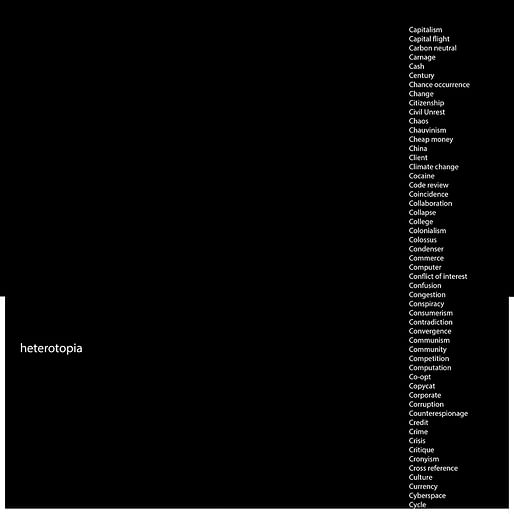
Nov '14 - Apr '21
With a few projects on hold and other initiatives about to start Construction, my Office sought an opportune moment to re-read Delirious New York within the context of the 14th International Venice Biennale.
First published in 1978, Rem Koolhaas’s ‘Retroactive Manifesto for Manhattan’ has been widely translated and has gained mythic status among Students, Architects, Urban Planners, Theorists, Filmmakers, and anyone who is fascinated with the continuing evolution of New York City.
Examining the vast Architectural Survey in Venice, we speculated about how to format a postscript to Delirious New York (1978-2014). While that question is still up in the air, it might be possible to shed light on late 20th Century and early 21st Century developments in New York City, and its global reverberations.
Applying Michel Foucault’s concept of Other Spaces and the theme from Perspecta 47: MONEY, the proposed Pop-Up Event entitled “HETEROTOPIA” highlights New York City’s drive towards modernization and architectural innovation from 1914 – 2014.


Discrete events dispersed across the Grounds add a new Programmatic layer to the Exhibition, illustrating the effects of Industrialization, building science innovations, economic cycles, social movements, and popular culture.

1. OLD WORLD TO NEW WORLD
Originating as a 9th-century lighthouse, St. Mark’s Campanile (1549) is one of the most recognizable symbols of Venice. The Renaissance structure has inspired countless designs and replicas across four continents, including New York’s Met Life Tower which stood as the world’s tallest building from 1909 – 1913. From 1914 onwards, architects borrowed less from the Old World and developed a new and modern skyscraper expression.

2. MODERN ICONS
Conceived during the roaring twenties, the Chrysler Building (1930) and the Empire State Building (1931) are distinguished by monumental illuminated spires that have become New York architectural trademarks. Dubbed the 8th Wonder of the World, the Empire State Building stood as the world’s tallest building for nearly 40 years and has inspired modern skylines around the world.

3. CORPORATE GLAMOUR
Symbolic of the transparency, honesty, and confidence of postwar corporate America, SOM’s Lever House (1952) and Mies van der Rohe's Seagram Building (1958) are icons that inspired buildings around the world. Reminiscent of 1950s high modernism, a luminous canopy structure houses an after-hours club, juxtaposing the veneer of corporate activity and efficiency against nature and excess.

4. NEON DREAMS
Neon signs are synonymous with the bygone age of Times Square, when it was known as the "Devil’s Playground." As depicted in "Midnight Cowboy" (1969) and "Taxi Driver' (1976), Times Square was gritty, dark, and desperate. City mandated clean-up efforts began in the 1980s, followed by the 1990s “Disneyfication.” Within architecture, much change has occurred since the 1970s but the hustler mentality carries on.

5. RUINS AND REBUILDING
Eclipsing the Empire State Building, The World Trade Center (1972) held the record for the world’s tallest building for 2 years. In 2001, it was destroyed by terrorist acts of an unprecedented scale. Presided over by developers, bureaucrats, star architects, amateur fantasists, and the global media, the sixteen-acre redevelopment is one of the most charged building projects of the century, and an attempt to raise a new icon amidst conflicting interests.

6. PROTEST AND OCCUPY
In a city known for its in-your-face persona, New Yorkers have demonstrated on the streets over the past century for causes as diverse as civil rights, overseas conflict, sexual orientation, religious freedom, climate change, low wages, and rising inequality. The Occupy Wall Street movement (2011) which began in New York’s Financial District has parallels with countless movements in the Middle East, Europe, and Asia.

7. POST CRISIS
After the financial crisis of 2007-2008, many Italian luxury brands went public to raise funds. The wave of global investment financed new “Cathedrals of Consumption." As stated in Perspecta 47“Money plays a paradoxical role in the creation of architecture. Formless itself, money is a fundamental form giver ...”. The multi-disciplinary and polyphonic space of Monditalia hosts a runway show against a backdrop of stock indexes, demonstrating the co-dependency of fashion, architecture, and global finance.

8. UNDERGROUND ECONOMY
In New York City, a vast underground economy bridges the divide between the prosperous elites, struggling locals, and low-income immigrants. A wide range of architectural activity is financed by an invisible network of illicit transactions ranging from street level drug deals to money laundering to billion dollar Ponzi Schemes. In the big picture, the exact degree to which architects are complicit with the underground economy remains unclear.

9. GLOBAL PLAYGROUND
Made possible by air rights transfers, real estate speculation, sophisticated engineering, and advances in material technology, super-tall luxury residential towers in New York City have proliferated over the past decade. Ranging from 50 to 90 stories, these pencil-thin buildings represent a new subset within the well-established skyscraper typology. Due to the influx of foreign real estate investment, record breaking sales figures have been reported.

10. NEW ORDER
Following this hundred year survey of New York Architecture (1914-2014), it appears that the skyscraper typology has reached its limit. In the wake of Hurricane Sandy (2012), perhaps future innovation will involve coastal structures that mitigate the effects of climate change, and the emergence of a new Nomadic Architecture Office?
CONCEPT DESIGN & IMAGE COPYRIGHT : ALTA Architecture P.C., Natalie Cheng, Brent Solomon
Special thanks to Yun Yun for photographic contribution.
This speculative project was carried out in the background while producing Mood Boards, Construction Documents, Plumbing Specifications, and Permit applications. While Musicians generally have a lot more fun working together, Architects who find common ground can prosper.
Design / Architecture / Art / Pop-Culture / Current Events
No Comments
Block this user
Are you sure you want to block this user and hide all related comments throughout the site?
Archinect
This is your first comment on Archinect. Your comment will be visible once approved.